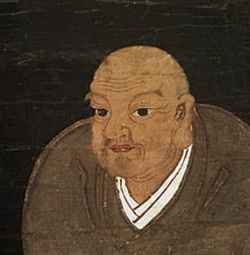Nichiren’s Training at Seicho-ji
“Nichiren Shonin first entered the temple in 1233 receiving his instructions under the direction of Master Dozen. age sixteen, Nichiren received the tonsure under the auspices of his master Dozen He then entered the Buddhist priesthood receiving the name of Zeshobo Rencho.” — from: Nichiren Shonin and His Relationship with Seichoji Temple When Zennichi entered the seminary in 1233, he probably underwent Jukai{Taking the Precepts}, as an acolyte monk, and recieved the Dharma name Yakuo-bo. Then, on October 8 1237, Yakuo underwent an Ordination, probably to become a Shami or Novice Minister. He was given the new Dharma Name Zesho bo Rencho (Lotus Eternal).
I am not exactly sure how this worked. The depictions appear to be of a Teido {Tonsure} or Tokudo-shiki {Ordination Ceremony}. The tonsure symbolizes the cutting of delusion.
This would not have been the same thing as a full legal ordination from either the Mt. Hiei Mahayana Kaidan, or one of the three Vinaya Precept Platforms. If I learn more, this will be up-dated again.
Kokuzo-Bosatsu, Space Treasury.
The chief deity of Seicho-ji was originally Akasagarbha, known as Kokuzo Bosatsu in Japan. The Temple was built around an ancient shrine to Kokuzo. Even though it is now a Nichiren Temple, there is still a Kokuzo Hall; though not the original; as well as Halls dedicated to Hotei and other traditional Buddhist Divinities.
When Rencho was still a teen, he underwent a 21 day “Morning Star” prayer vigil at the Kokuzo Hall. The mantra of Kokuzo is Nobo akyasha kyarabaya on arikya mari bori sowaka or, in Sanskrit; Namo Âkâsagarbhaya om ârya kamari mauli svâhâ. This means: Hail Space Treasury who holds a flower and wears a garland and a jeweled crown, amen.
Rencho prayed to Akasagarbha Bodhisattva (Kokuzo-Bosatsu, Angel Space Treasury, Vast and Boundless Vessel) to make him the wisest man in Japan. On the twenty-first day of his prayer vigil, he had a vision, in which he received a precious cinta-mani jewel from an old monk.
“The bodhisattva transformed himself into a venerable priest before my very eyes and bestowed upon me a jewel of wisdom as bright as the morning star. No doubt as a result, I was able to gain a general mastery of the principal teachings of the eight older schools of Buddhism in Japan, as well as of those of the Zen and Nembutsu schools.” — Nichiren It is said that, after emerging from this intense vigil, Rencho vomited blood. Red tinged bamboo then grew at the spot, and remains to this day.
“In between the Image Hall and the Founder’s Hall is located the little protected stand of “bloody bamboo”. According to legend, Nichiren fasted and prayed before the Kokuzo image for 20 (or 21) days. When he finally rose from his devotions, after receiving the jewel of wisdom from Kokuzo, he left the hall, and vomited blood. Ever afterwards, this stand of bamboo has had red highlights (very rare) and at certain times of the year becomes quite red.” –Engyo’s Pilgrimage Diary: Seicho-ji first day Next, in a little over a year’s time, Zesho-bo Rencho is said to have read the entire collection of sutras and commentaries in the Seicho-ji temple library. He soon realized that the library there was too small for him. In the spring of 1239, he apparently gained permission to continue his studies at the Tsurugaoka Hachiman Shrine-Temple, in Kamakura, located across the bay.
